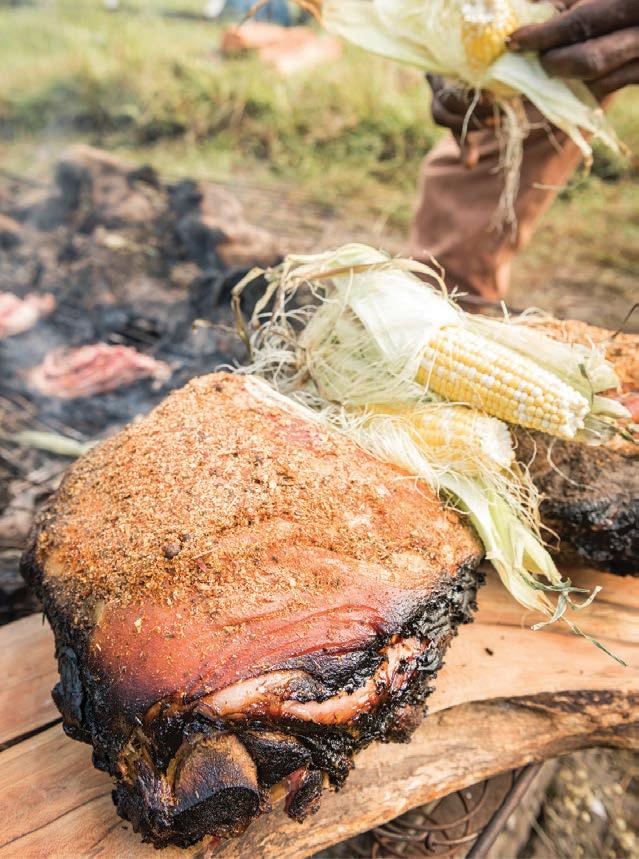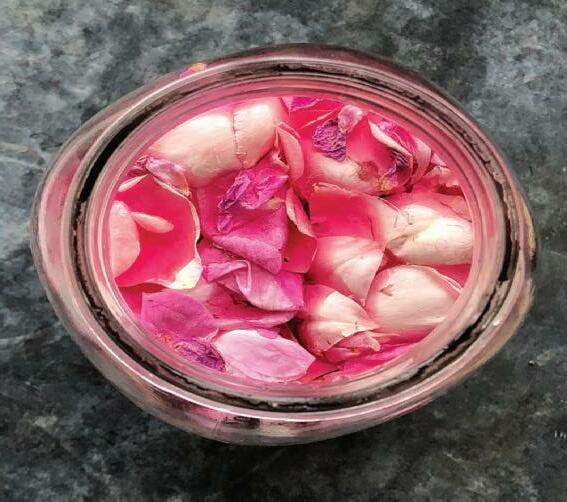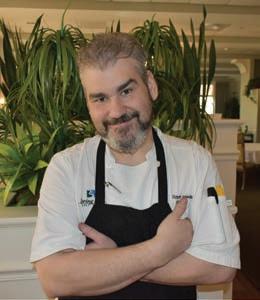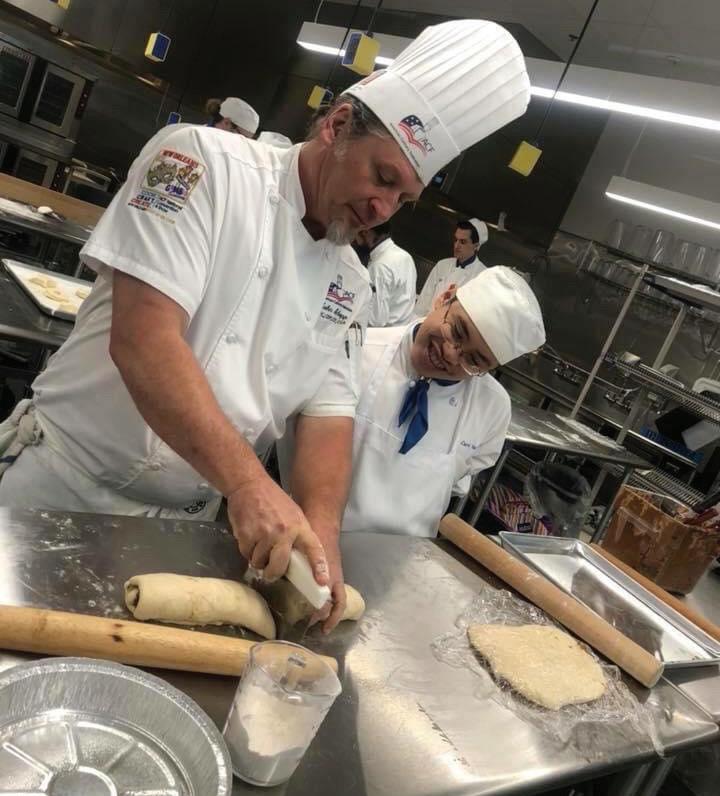
17 minute read
Southern American French Cuisine
from National Culinary Review (Nov/Dec 2021)
by National Culinary Review (an American Culinary Federation publication)
French cuisine and the American South are more interwoven than one might think // By Chef Jennifer Hill Booker


My family is from the deep South — the Mississippi Delta to be exact. We come from a long line of farmers and great cooks. I grew up watching my grandparents and great aunts and uncles grow and harvest crops, as well as fish and raise livestock, and then turn all of those beautiful fruits and vegetables, fresh eggs and seafood, butter, milk, chickens and hogs into delicious meals. What wasn’t immediately eaten was canned or preserved for a rainy day — my favorites being my grandmother’s peach preserves and Aunt Sis’s fresh churned butter. Years later as an adult, I grew to appreciate my mother’s elderberry wine.
I knew that many of the ingredients I grew up eating, like black-eyed peas and okra, were brought to America by African slaves. What I didn’t realize until later, however, is that many of the dishes and cooking methods I grew up with were influenced by the French.
I believe my culinary ignorance was due to the fact that when asked where to find French food in the South, most people — and myself included — only considered the city of New Orleans. There, you will definitely find a strong food scene where both Creole and Cajun cuisines have their origins firmly rooted in the French occupation of Louisiana. Creole dishes like red beans and rice and shrimp Creole or Cajun favorites like boudin and jambalaya, in that regard, are undeniably French. But if you look closer,


Chef Jennifer Hill Booker (opposite) is a cookbook author who specializes in Southern-American-French cuisine; Sweet potato crepes (left) and collard greens salad (right) by Chef Booker.
you will find other, more subtle, Frenchinspired dishes all over the South. You just have to know where to look.
It took going to culinary school for me to find them. Through my culinary training here in the United States and in France, I was taught classical French cooking methods. I learned how to cut and chop, make sauces and stews, bake and roast and even became a decent baker. What I remember most was that a lot of the cooking methods I was taught were the same I learned from family while growing up. Even while studying in Paris, I used many of the same ingredients I cooked with at home, including purple-hulled peas, rabbit and even just good quality cheese, pasta and milk for a fancy version of macaroni and cheese. That’s what surprised me the most: discovering the huge influence French cuisine has had on the food of the American South.
Once back to cooking in the States, I easily recognized which cooking methods, ingredients and presentations had French roots — but that Southerners had made their own.
Southern Twists
There are many traditional French favorites that Southerners have made their own. Take a look.
A souffle is a dish that is made from a sauce of egg yolks, beaten egg whites and a flavoring or puree — and then baked until puffed up. The Southern version of a French souffle has taken shape as a casserole, often topped with chopped nuts, marshmallows or meringue. These are very popular desserts during Thanksgiving and the winter holidays.
A meringue is a light mixture of stiffly beaten egg whites and sugar, baked until crisp or used as a fluffy topping on desserts. A light and fluffy meringue is a must-have as a baked garnish on top of classic Southern desserts like banana pudding and key lime pie. In these parts, the higher the meringue, the higher the praise for the cook.
A roux is a cooked mixture of equal parts flour and fat. When combined with liquid, such as milk or stock, a roux creates a thick and smooth sauce. It is the base that makes seafood gumbos in the South thick and creamy. A properly made roux makes for a lump-free sauce — just ask anyone from Louisiana.
Fondue refers to a dish made by warming cheese, oil or chocolate in a specially designed container over a small flame. A variety of foods can be dipped into the melted contents of the pot and then eaten as a starter, main course or as a dessert. Fondue made its debut in the South as a pot of melted cheese that you dipped chunks of bread in. Over the years, fondue has evolved into a chocolate fountain where you dip chunks of cake into melted chocolate.
In traditional French cuisine, a terrine is a loaf of chopped meat, spices and gelatin baked in a covered pottery mold, which is also referred to as a terrine. Taking inspiration from classic French terrines of chopped wild game, such as duck, boar or rabbit, many Southern-style terrines are made from the trimmings of butchered pigs. These terrines of spiced pork are chilled instead of baked and fondly called hog head cheese or souse.
Much of that influence has to do with the reputation French chefs have in the American food scene, along with the many French cooking techniques and kitchen management styles adopted in American commercial kitchens. And of course, there are still culinary schools that teach classical French cooking as the only acceptable cooking method. That — plus the food legacy left behind by freed French-owned slaves — meant that French methods, ingredients and dishes have remained a robust part of the Southern culinary landscape. Many freed slaves remained in the South, cooking the foods of their former owners, mixed with ingredients and cooking techniques from the freed slaves’ homelands.
So, what have we Southerners taken from the French and adopted as our own? I immediately think of the low and slow cooking method of braising, which you’ll see used on a pot of pinto beans or turkey wings. The way I roll and cut my greens into long strips for a salad is another example of French cuisine’s seamless influence on our everyday cooking.
When it comes to Southern favorites, I think we’ve taken the best of what a classic French dish has to offer and added our indigenous ingredients to create dishes that are truly our own. Take for example sweet potato souffle or banana pudding. Both use a French-style custard made of egg yolks, cream, sugar and flavoring, but with sweet potatoes or bananas as their main ingredients.
The cheese sauce in the macaroni and cheese recipes Southern cooks are known for has its foundation in a French “mother sauce,” but the types of cheeses, addition of bacon or pimentos and a topping of buttered crackers is truly Southern. I would go so far as to say that a Thanksgiving favorite, the turducken, is essentially a French ballotine.
I’m not saying that French and Southern cuisines are the same since both are unique in what they offer and how food is prepared and presented. But in the end, I will say that French and Southern Cuisine are indeed different sides of the same culinary coin.
Southern-born Chef Jennifer Hill Booker traveled to Paris to study French cooking at Le Cordon Bleu College of Culinary Arts only to discover that rustic French and Southern dishes use many of the same ingredients. That’s the basis for culinary exploration in her cookbooks, including “Dinner Déjà Vu: Southern Tonight, French Tomorrow” and “Field Peas to Foie Gras: Southern Recipes with a French Accent.” Chef Booker is a graduate of Le Cordon Bleu College of Culinary Arts in Paris. In addition to her work as a chef, entrepreneur and cookbook author, Chef Booker is a reality TV personality, culinary educator, an Impact Fellow with the James Beard Foundation and a Georgia Grown Executive Chef for the state’s Department of Agriculture. Learn more at ChefJenniferHillBooker.com.

Hog Head Cheese
Recipe by Chef Jennifer Hill Booker
This truly Southern dish, also known as souse, takes its lead from the French terrine.
Hog head cheese closely resembles pâté — minus the gelatin, which isn’t needed since the pork bones cook down into a flavorful collagen that binds tender pieces of pork with bright herbs and spices.
Yield: about 16 servings
1 large hog head, brain removed, about 10 pounds 4 large onions, peeled and quartered 8 large garlic cloves, peeled 2 tablespoons sea salt 1 tablespoon fresh ground black pepper 1 teaspoon red pepper flakes 1 teaspoon rubbed sage 1 cup cider vinegar
1. Clean hog head by removing eyes and any remaining bristles.
2. In an extra large stock pot, bring the hog’s head, onions, garlic, salt, black pepper, red pepper flakes, vinegar and enough cold water to cover by 2 inches to a rolling boil.
3. Reduce heat to medium-low and simmer until meat is falling off the bones, about 3 hours.
4. Allow meat to cool in the cooking liquid until able to handle with bare hands.
5. Pick the meat off the bones, chopping the meat and cooked onions to desired consistency. Reserve 2 to 3 cups of cooking liquid and discard the bones.
6. Pour reserved cooking liquid into meat and onion mixture. Add vinegar, salt, black pepper, red pepper flakes and sage to taste.
7. Pour meat and spice mixture into large 9 -x 12-inch pans and allow to cool refrigerated overnight.
8. Once chilled, cut the hog head cheese into squares and serve with saltine crackers or slices of white bread.


Sweet Potato Crepes with Bourbon Caramel Sauce
Recipe by Chef Jennifer Hill Booker
This Southern spin on a French classic is a flavorful way to use leftover roasted sweet potatoes. If you have leftover bourbon caramel sauce (which I doubt), it’s delicious on muffins and over ice cream.
Yield: about 1 dozen crepes
1/2 cup mashed roasted sweet potato, skin removed 2 large eggs, beaten 1/2 cup whole milk 1/2 cup water 1 cup all-purpose flour 1/4 teaspoon cinnamon Pinch ground cloves 4 tablespoons melted butter, plus more for greasing Pinch salt
1. Combine all of the crepe ingredients in a large bowl and whisk until smooth and lump free, about 10 minutes.
2. Place the crepe batter in the refrigerator and chill for at least 1 hour to overnight. This allows the air bubbles in the batter to subside so the crepes will be less likely to tear during cooking.
3. Heat a 6-inch nonstick crepe pan over medium heat, until pan is hot but not smoking.
4. Add butter to coat, about 1 teaspoon, swirl over bottom of pan and pour off any extra butter. Pour 1 ounce of batter into the center of the pan and swirl to spread evenly. Cook for 30 seconds.
5. Remove the pan from the stove and using a rubber spatula, quickly loosen the edges of the batter away from the pan, then, using the spatula and your fingers, flip the crepe over very carefully.
6. Place the pan back on the stove and cook the crepe for another 30 seconds and remove, placing the crepe flat on a cookie sheet lined with parchment paper. Continue until all batter is used. Refrigerated leftover batter will keep for up to 2 days.
7. After the crepes have cooled, you can fill them with your choice of filling, like ice cream, and serve warm with bourbon caramel sauce.
Bourbon Caramel Sauce


Recipe by Chef Jennifer Hill Booker
A decadent blend of browned sugar, rich cream and smoky bourbon. This sauce is delightful on sweet potato crepes, waffles and, of course, over your favorite ice cream.
Yield: about 1 cup
1 cup sugar 1/4 cup water 1/2 cup heavy cream 2 tablespoons bourbon 1/4 teasponn salt
1. Simmer sugar and water in a small heavy bottomed saucepan over medium-low heat. Swirl the pan, occasionally, until the sugar water is a dark amber color, about 30 minutes. Brush the sides of the pan down with a pastry brush dipped in cold water; this will keep any sugar on the sides of the pan from burning.
2. Do not walk away from the pan. Once the mixture starts to brown, it goes very quickly.
3. Remove the pan from heat and slowly stir in the cream. Add the salt and bourbon, place back on the burner and cook until the caramel sauce is thick, about 5 minutes, stirring constantly. Remove from the heat and transfer to a heat-safe dish or bottle and serve warm.
4. Store any remaining sauce in an airtight container and refrigerate.
MICHAEL J. SHANNON, CEC
Executive Chef, Somerset Club, Boston, Massachusetts // By Amelia Levin
Chef Michael Shannon, CEC, was always surrounded by good food as a child, growing up in a Italian-Irish household in the suburbs of Chicago. “We had dinner every night as a family and our conversations around the dinner table deepened my appreciation for food and cooking,” says the 2021 ACF Chef of the Year (more on that in a bit).
Spurred by this passion, Chef Shannon decided to enroll in the culinary arts program at Joliet Junior College, during which time he worked part-time at some local restaurants in the area.
But it was competitions and the private club world that would eventually call his name, having met ACF members and club chefs as part of the 2011 ACF Culinary Student Team that won nationals. “My Chef-Instructor Tim Bucci (CMC) at the time was on the Culinary Olympic team with Chef Joe Leonardi (CMC), so I connected with him,” says Chef Shannon, who would later to go work for Leonardi at Somerset Club in Boston after graduation.
“I have been at Somerset for nine years now,” says Chef Shannon, who worked up the ranks as line cook, sous chef and now executive chef. Watching Chef Leonardi study for and earn his CMC caused Chef Shannon to have an even deeper respect for his mentor. “[Going for my CMC] is something that I consider a career goal of mine,” he says.
Taking over the executive chef position at Somerset was a key step toward that goal. “I was just 26 years old at the time. Looking back, that was a lot of a responsibility at that age,” says, Chef Shannon, noting that was about five years ago. “I was lucky to have one of my best friends Geoffrey Lanez as my sous chef at the time. For as much as this was a big step for me, we did it together.”
Cool, collected and well-spoken, Chef since then focused on running his kitchen with order and organization, respect for each other, and with an embrace of all the different personalities that can come about in an elaborate kitchen structure, such as at Somerset.
When asked what his strength is, Chef Shannon remains humble, but goes on to suggest that perhaps it is his ability to “manage personalities.” “A lot of the time I feel like I’m falling short in that regard because everyone is so different, but I try to work hardest on mentorship and creating a good culture. It’s definitely something I feel like I’m always working on.”
Chef Shannon says he enjoys working in the club sector primarily because of the support from membership. “That’s something I have really valued throughout the years,” he says. “With a membership base, you have to be continually evolving because you might see some of the same people multiple times a week. You have to keep the menu fresh, otherwise things can get stagnant pretty quickly.”
That means Chef Shannon has to stay on top of his game at all times. He gets his inspiration for new dishes and menu ideas by reading cookbooks, focusing on seasonal ingredients, and social media platforms. “I personally get really inspired by my cooks at the club when they are excited to learn about something new or share their ideas with me,” he says. “When you have multiple dining outlets, you need a strong team — It’s all part of a collaborative effort.”
Competitions are also a way for Chef Shannon to get new ideas and hone his craft. His first experience with competition came during culinary school at a regional competition in Columbus, Ohio, where he took home gold medal in a K category at the student level. “It was a happy drive back,” he says.
Later, Chef Shannon went on to win Best in Show in 2012 for a cold food platter he presented at a competition in
New York. He also won gold and Best in Show at a mystery basket competition in Cincinnati in 2018. To practice for this competition, he had his cooks and sous chefs put together mystery boxes for him and hide it just before practice time.
“Competitions are not for everyone –they are demanding both physically and mentally,” says Chef Shannon. “But I find them to be a great way to keep learning, develop good work habits and improve your time management skills—which is like a secret weapon as a cook. [Competitions] are also great for building comradery in the kitchen because they create an outside goal that the whole culinary team can all rally behind.”
For his most recent competition at the 2021 ACF National Convention in Orlando, Chef Shannon pulled these tricks out of his sleeve to remain cool, calm and collected under the pressure. It was his rabbit, arctic char, and peach salad that helped him beat out nine other competitors. For the rabbit, Chef Shannon made a sausage utilizing the leg of the rabbit, rabbit liver, along with some bacon and roasted garlic. He then boned out and stuffed the rabbit saddle with the sausage. The dish also was composed of a savory cornbread pudding with braised rabbit and slow-cooked summer vegetables with basil and truffle. For the fish appetizer, he made a poached arctic char dish featuring a terrine made with the loin, a mousseline with the trimmings and some char meat from the tail, as well as a stuffed pasta made with the belly, which he smoked for extra flavor.
For the salad course, Chef Shannon went for a play on peaches and cream using peaches macerated with mint and Riesling wine, a light buttermilk panna, and a simple, lemon verbena-Champaign vinaigrette. The dish also featured a black pepper and peach chutney made with the leftover trimmings and a brioche crisp for texture.
“Finding ways to utilize the whole fish, whole animal or whole vegetable is really important to me and builds good habits in the kitchen so there is no waste,” he says.
Chef Shannon’s goals for the short term are to continue to strive to create a positive environment and a place where younger cooks, especially recent culinary student graduates, are excited to come to work at. “Work-life balance is an important part of that,” says Chef Shannon, who believes in supporting time off and moving away from an industry culture that has been “kind of rough for a very long time.”
The future is here, though, and Chef Shannon wants to be a part of change to come in the industry. “I still have a note that Chef Leonardi wrote on the inside of a notebook hanging in my office,” he says. “It says ‘promise to give so much time to improve yourself and your team that you have no time to criticize others.’ There has been a lot of negativity in our society and industry lately so I try to focus on things I can control. I focus on not taking my team for granted and always putting my best foot forward.” "THERE HAS BEEN A LOT OF NEGATIVITY IN OUR SOCIETY AND INDUSTRY LATELY, SO I TRY TO FOCUS ON THINGS I CAN CONTROL. I FOCUS ON NOT TAKING MY TEAM FOR GRANTED AND ALWAYS PUTTING MY BEST FOOT FORWARD.”

Michael J. Shannon, CEC, Executive Chef, Somerset Club, Boston, Massachusetts







